It’s no secret that photo editing and retouching make photographs more vibrant, captivating, and sometimes picture-perfect. But what sets them apart? If you’ve ever wondered, “What is the difference between photo editing and retouching?” you’re in the right place.
Photo editing involves general adjustments that aim to boost an image’s quality or alter its appearance. Retouching, on the other hand, delves into the details, targeting specific flaws to polish, enhance, or even dramatically change the mood or atmosphere of a photo.
Stick around as we explore this topic further and uncover the nuances that differentiate these two art forms. We will guide you through the when, why, and how of using each technique to its fullest potential.
What is the Photo Editing and Retouching Service?
Photo editing and retouching are your go-to for turning ordinary shots into masterpieces. These services adjust colors, balance lighting, and tweak the overall ambiance, ensuring your photos look their absolute finest. It’s like giving your images a professional makeover, tailoring them to your exact needs and preferences.
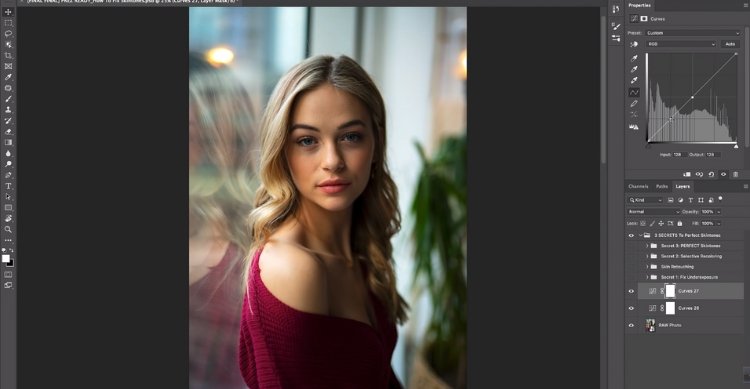
On the other hand, retouching focuses on the finer details, meticulously removing blemishes, smoothing out wrinkles, and even altering backgrounds. This specialized attention, particularly in high-end fashion photo retouching, can elevate a simple photo into a work of art, creating visuals that stand out in any portfolio or gallery. Whether it’s for personal memories or professional branding, these services craft the most compelling image that tells your unique story.
What is the Difference Between Photo Editing and Retouching?
Many people wonder what the difference is between photo editing and retouching as they enter the digital world of photography. While both are pivotal in transforming images, their applications and outcomes diverge significantly. Here’s a look at what makes these processes unique.
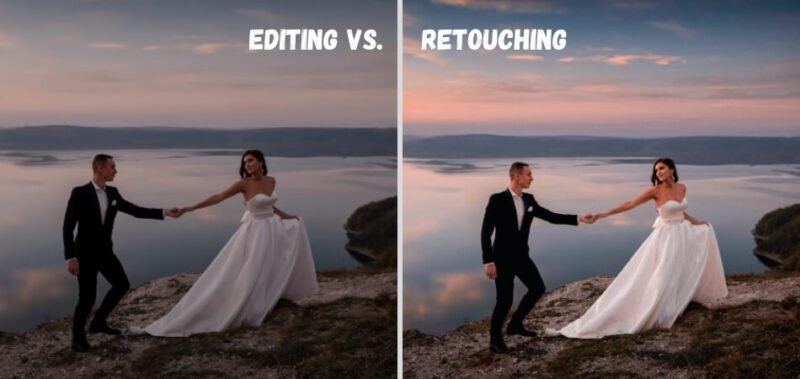
Objective and Scope
Photo editing is the backbone of image enhancement, focusing on basic adjustments like color correction, exposure, and contrast. It’s about refining what’s already there, ensuring the photo looks polished and professional. Editing lays the groundwork for a good photograph, setting the tone and mood without altering the essence.
Retouching, however, is more intricate, aiming to perfect the image by removing unwanted elements. This could mean erasing blemishes, smoothing skin, or even adding or removing objects. It’s the art of making subtle changes that enhance the subject’s beauty without it being obvious.
Tools and Techniques
Editing tools are broad and applied to the entire image to adjust brightness, saturation, and crop. These adjustments are like tuning a musical instrument, ensuring it sounds right. It’s a universal approach to improve image quality.
Retouching uses specialized tools to target specific areas or imperfections. Think of it as painting, where each brush stroke is deliberate, focusing on detail and perfection. It’s about precision and meticulous attention to detail.
Time and Effort
Generally, photo editing is quicker, dealing with global adjustments that affect the whole image. It’s efficient, allowing for a swift enhancement of numerous photos in a batch. Editing is the fast track to elevating image aesthetics.
Retouching is more time-consuming, given its focus on the minutiae. Each photo is a project requiring patience and a steady hand. This painstaking process is what makes retouching a craft.
Skill Level
Editing is often achievable with basic skills, making it accessible to amateurs and professionals alike. It’s the starting point for anyone looking to improve their photos. Simple tweaks can make a big difference.
Retouching demands a higher skill level, combining artistry with technical proficiency. It requires an eye for detail and an understanding of how minor adjustments can transform a photo. So, properly retouching fashion photos is where technique meets creativity. Retouching is where technique meets creativity.
Impact on the Final Image
Editing enhances the photo’s natural beauty, maintaining the original feel and boosting appeal. It’s about elevating the photo to its best version. The impact is subtle but significant.
Retouching can dramatically change the perception of an image, altering its narrative or focus. The final touch can turn a good photo into an unforgettable one. The transformation can be astounding.
In the dance of pixels and creativity, photo editing and retouching play pivotal roles, each with its rhythm and steps. Photographers and enthusiasts need to understand their differences to bring their visions to life.
Whether you’re fine-tuning or transforming, each process has its place in the journey from snapshot to masterpiece. Embrace both, and watch your images unfold to their fullest potential.
Pros and Cons of Photo Editing
Today, photo editing is integral to photography, enabling pros and amateurs to improve their pictures. It can fix simple mistakes and turn ordinary into extraordinary, among other things. However, it’s not without its flaws.
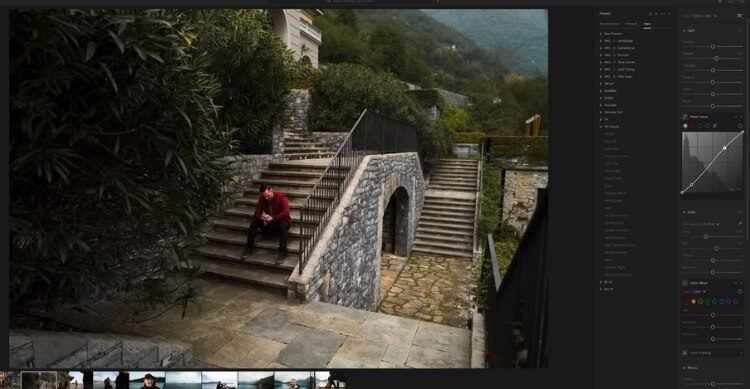
Here are the pros and cons of photo editing.
Pros
- Enhances photo quality: Brightens, sharpens, and corrects colors, making images more appealing.
- Corrects errors: Easily fixes common issues like red eyes and lighting problems.
- Allows creativity: Unlocks limitless creative possibilities, from subtle adjustments to dramatic alterations.
- Boosts professionalism: Professional-looking photos can significantly enhance brand perception and appeal.
- Saves money: Reduces the need for expensive reshoots by correcting mistakes in post-production.
- Preserves memories: Restores and enhances old or damaged photographs, keeping memories alive.
- Adaptable for different uses: Adjusts images to be suitable for various platforms and purposes.
Cons
- Time-consuming: Requires significant time investment, especially for detailed edits.
- Requires skill: Effective editing demands learning and mastering software tools.
- Can be deceptive: Over-editing can lead to unrealistic expectations and perceptions.
Pros and Cons of Photo Retouching
Photo retouching is a specialized craft aimed at refining images to near perfection. It transforms ordinary photos into visually stunning pieces, highlighting the beauty and removing distractions. Even so, it’s important to recognize its limitations and downsides.
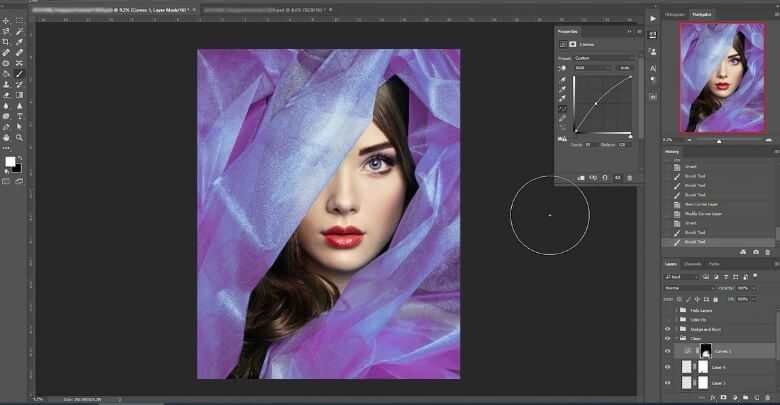
Here are the pros and cons of photo retouching:
Pros
- Improves aesthetic appeal: Beautifies images, making subjects and settings look their best.
- Corrects imperfections: Expertly removes blemishes, wrinkles, and other distractions.
- Enhances mood: Adjusts lighting and colors to create or enhance a specific atmosphere.
- Focuses on details: Allows meticulous attention to detail, enhancing even the smallest elements.
- Ideal for professional use: Essential for fashion, product, and portrait photography where perfection is expected.
- Customizable: Tailors images to fit specific themes or branding requirements.
- Boosts confidence: Can improve subject self-image by presenting a polished version of themselves.
Cons
- Time-intensive: Each photo can require extensive time to retouch properly.
- Skills required: Demands a high level of expertise in photo editing software.
- Potential for overuse: This can lead to unnatural or overly processed images.
Photo Editing Vs Retouching – Which One Should You Choose?
It is important to consider your specific needs, goals, and project context when choosing between photo editing and retouching. Both techniques offer unique benefits and are suited to different photographic enhancements. Here’s a breakdown to help you decide which route is best for your images.
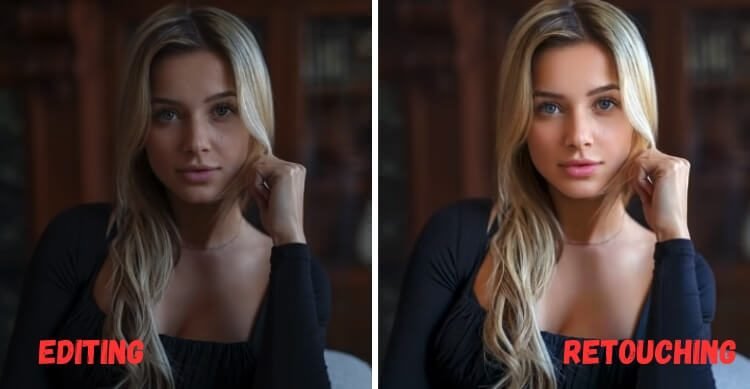
When to Choose Photo Editing
- Broad Adjustments: If your photo requires overall improvements such as color correction, exposure adjustment, or cropping, photo editing is your go-to. It’s about enhancing the entire image to make it more visually appealing.
- Large Batches: Editing can often be applied to groups of photos for consistent adjustments, making it ideal for events or when dealing with numerous similar shots.
- Quick Fixes: When time is of the essence, and you need to make general enhancements quickly, editing can provide the swift turnaround you need.
When to Opt for Retouching
- Detail-Oriented Enhancements: If your focus is on correcting or improving specific elements within an image, such as removing blemishes, smoothing out wrinkles, or adjusting the background, retouching is the answer. It’s all about the details.
- High-End Photography: For professional portraits, fashion photography, or commercial images where perfection is key, retouching can provide the meticulous attention to detail required.
- Creative Alterations: When you want to alter aspects of your photo or add artistic elements significantly, retouching allows for the precision and creativity needed.
Making the Decision
The choice between editing and retouching ultimately comes down to the outcome you wish to achieve. If your goal is to enhance the overall look of your photos without altering the reality too much, photo editing should suffice. However, retouching is the way forward if you’re aiming for perfection or need to make precise changes to specific parts of your image.
A Balanced Approach
Remember, both editing and retouching can be used to achieve the best of both worlds. Starting with a solid foundation through editing and following up with detailed retouching can bring out the best in your photos. It’s also worth considering your skill level, the time you can dedicate to the process, and the message you wish to convey through your images.
Whether you lean towards photo editing or retouching, the choice should align with your photographic vision and the story you want to tell. By understanding the strengths and applications of each technique, you can make informed decisions that elevate your photography and accurately reflect your creative intent.
Frequently Asked Questions about What is the Difference Between Photo Editing and Retouching?
When exploring photography, the terms “photo editing” and “retouching” often come up, leading to confusion about their differences. To help clarify, here are some frequently asked questions that shed light on the distinctions between these two processes.
Is Photo Retouching Considered Unethical?
Retouching is not inherently unethical; it becomes a concern when used to create unrealistic beauty standards or deceive viewers. Ethical retouching respects the integrity of the subject and the photograph, aiming to subtly enhance rather than drastically alter.
Can I Do Both Photo Editing and Retouching on the Same Image?
Yes, combining photo editing and retouching is common practice. Start with editing for overall enhancements, then apply retouching techniques for detailed improvements. This approach ensures the image is polished and refined at both the macro and micro levels.
Do Professionals Always Retouch Their Photos?
Not all professional photos undergo retouching. The decision depends on the purpose of the image, client requirements, and the photographer’s style. Some scenarios demand retouching for a flawless finish, while others may benefit from a more natural look.
How Do I Know if My Photo Needs Editing or Retouching?
Evaluate the photo’s current state and your desired outcome. If the image needs general improvements in lighting, color, or composition, go for editing. If specific issues like blemishes or distracting elements need addressing, retouching is more appropriate.
Does Retouching Take Longer Than Editing?
Generally, yes. Retouching is more time-consuming because it involves working on individual elements within the image, requiring precision and attention to detail. Editing, which applies changes across the entire photo, tends to be quicker.
Wrap Up
Enhancing images with photo editing and retouching can make the ordinary extraordinary. This elevates the visual storytelling of photographers and enthusiasts alike. As we’ve explored the distinct roles and benefits of each process, it’s clear that the choice between editing and retouching depends on the specific needs and vision behind every photograph.
While exploring, a common question arises: “How much does fashion photo retouching cost per image?” It depends on how much work is involved and how experienced the retoucher is.
Ultimately, whether you’re drawn to the broad strokes of editing or the detailed focus of retouching, both paths offer the power to realize your creative ideas, turning fleeting moments into lasting impressions.
